To an impact organizaton that’s working hard to create real systems for change, something as intangible as “nonprofit branding” may feel like the least important thing on the ever-growing to-do list.
But far from being a “nice to have” or “when we get to it” kind of thing, your nonprofit brand should be the foundation.
A poorly articulated, half-baked brand won’t necessarily prevent you from doing the important work you’re doing…but a great brand can take what you’re doing and multiply your impact to an incredible degree.
We’ve found that the idea that brand isn’t necessary or worthwhile most often comes from a misunderstanding of what nonprofit branding really is—and what it can do for your impact organization.
So what is nonprofit branding? And why does this concept matter to your impact organization?
Nonprofit Branding Isn’t Just a Feeling
In many ways, branding comes down to a feeling. It’s the feeling you want your community to have when they interact with you—whether donors or beneficiaries, whether online or in person. But it’s hard to justify an investment based on a feeling, right?
Let’s face it. There are a million other things to do, and the list is only growing (even right now, as you read this). Do you or your ED really have time to sit down for a brand strategy call?
You may not have the time just laying around, but you could probably find it. And it’s worth doing because your brand is a feeling—but it’s also so much more. In this article, we’ll look at highly practical, day-to-day benefits of a strong nonprofit brand.
Once you understand these very tangible benefits, the question won’t be, “Can we do this branding thing?” but instead—”Can we do this… NOW?!”
Let’s dive in.
Key Benefit #1: Makes Your Org Recognizable
A strong brand is a rallying cry for your impact organization.
People will know what you do and why you do it, and they’ll begin to associate a certain feeling with your nonprofit.
This clear sense of identity is just as important for a local nonprofit that serves a physical community as it is for creating that global community if you’re a primarily online nonprofit.
While few nonprofits will achieve such universal recognition through brand alone, the power of this concept is demonstrated by some of the best nonprofit brands (at least “best” in the sense of hugely successful and highly recognizable):
- TOMS
- Habitat for Humanity
- Amnesty International
- Greenpeace
- WWF
- World Vision
Greenpeace’s activist style may not be everyone’s favorite approach, but we can’t deny that the brand is solid! From the graffiti-inspired logo to the bold (…dare I say “aggressive”?) messaging, people who have seen Greenpeace know Greenpeace.
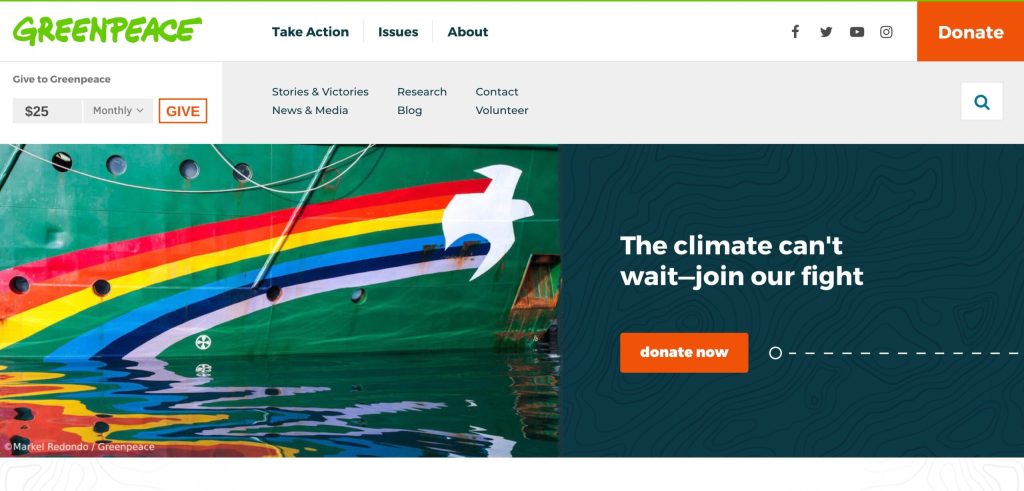
But these are all massive organizations, you might protest! You don’t have the manpower or the money to emulate them.
And that might be true. But good branding makes any-sized nonprofit more recognizable.
For example, when I was a Peace Corps Volunteer in South Africa (in a tiny, tiny, tiny village not listed on the Google Maps of yore), there were about five local orgs that everyone knew. When that one van crossed the river into the village, everyone knew exactly who it was based on that logo on the side of the van.
In fact, if you’re a smaller nonprofit that serves a very localized area, you have an even stronger opportunity to build recognition through your brand!
A strong nonprofit brand can help you become the biggest fish in your pond.
Key Benefit #2: Helps Retain Talented People

All of us working in or with the nonprofit sector do so out of some kind of personal conviction that we can make the world better. That WE can make the world better. That we CAN make the world better.
At the same time, though, we have to be honest.
Personal conviction isn’t enough.
Personal conviction is not enough to attract and retain talented staff, committed board members, or skilled volunteers for your nonprofit. There are simply too many organizations doing similar work to believe that yours is the only one that will fulfill someone’s life mission.
That’s where strong nonprofit branding can make a huge difference.
When your nonprofit brand is built on a powerful mission and clear core values (communicated both on your website and throughout your everyday interactions), you’ll find that:
- Potential board members are more willing to join the board of an organization that has a clear vision and plan for communicating its brand to the public. (This is critical, as over 50% of nonprofit board chairs report that it is either difficult or very difficult to find qualified board members!)
- Staff position applicants can easily assess whether or not they share your values and culture, increasing the likelihood of getting strong, good-fit applicants for key positions.
- Volunteers will have heard of you and actively want to join your work. They’ll be aligned with your core values and will feel more empowered to contribute in a meaningful way.
Key Benefit #3: Builds Trust
A clear storyline and central theme will establish your organization as being honest and straightforward.
In the same way that a professional-looking website says, “Yes, we can be trusted with your credit card information,” a clear nonprofit brand says that your staff can be trusted to carry out the mission you’ve set.
When you set clear expectations around what you stand for and why, people will feel more comfortable with you and are more willing to trust you.
Of course, brand isn’t everything with trust. A strong nonprofit brand will simply build on the elements that you’ve already put in place to build trust with your community—things like easy-to-find impact reports, frequent newsletter updates, and transparency with how donor funds are being used.
We’re never advocates of branding over substance but rather branding on substance.
Blessings in a Backpack is a great example of this. On top of a solid brand, they’ve incorporated all of the most important signifiers of trust and transparency: financial documents, contact information, donor privacy policy, and links to affiliations with trusted organizations like Charity Navigator.
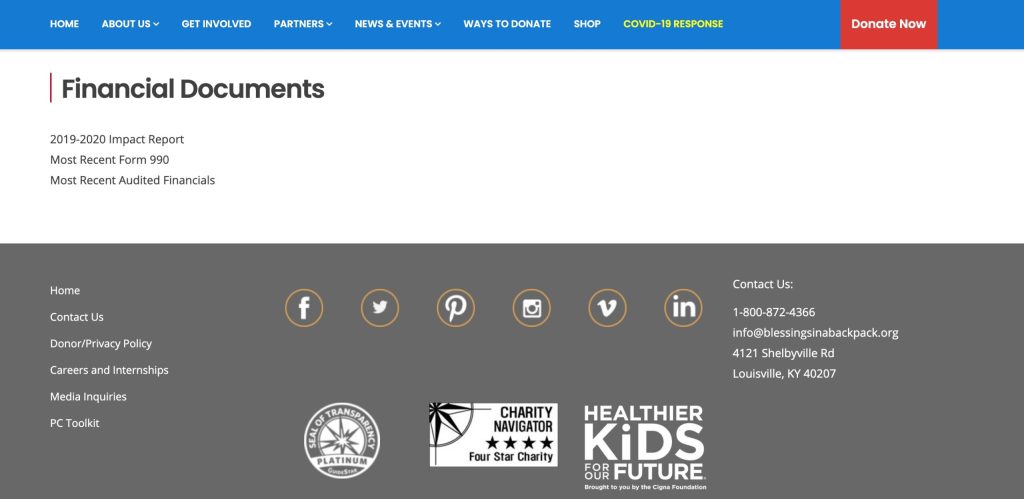
The Houston Food Bank provides another great example of trust-building elements. This food bank not only provides all of its key financial information in a very user-friendly and on-brand way, but it uses the copy on the page to emphasize the core values behind them.
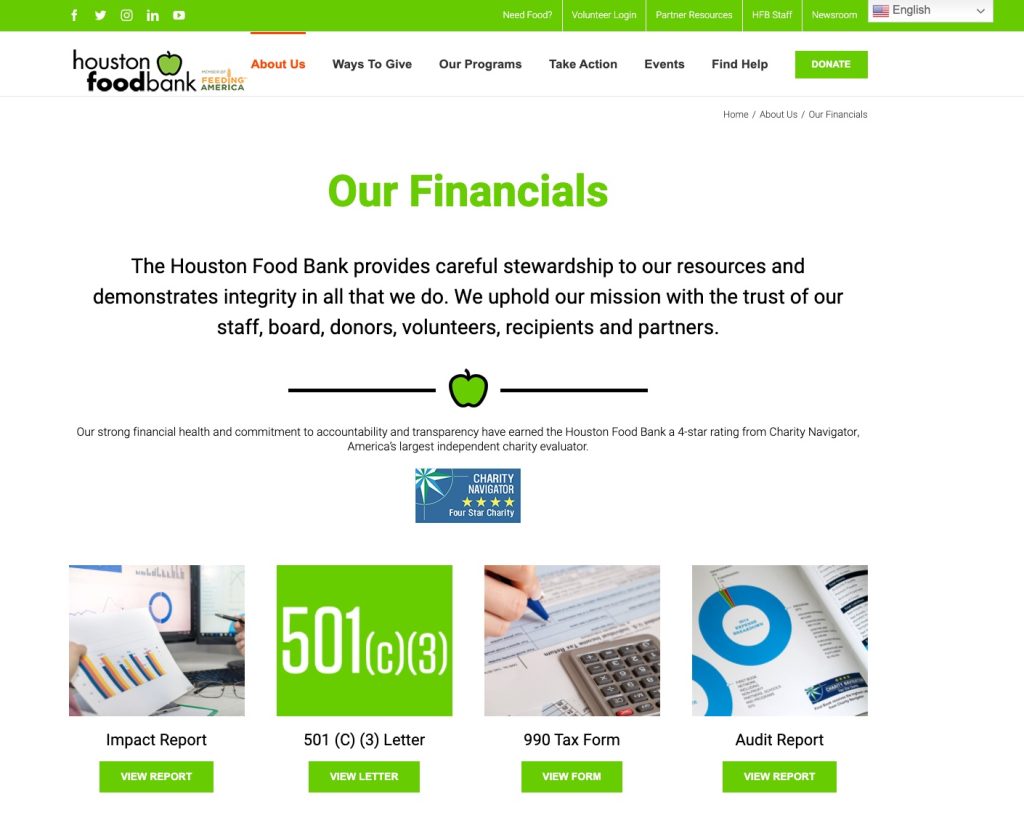
See? The Houston Food Bank is not just providing these documents because they are required for a 501c3 nonprofit—even if they are. Instead, it’s because they care about core values like “careful stewardship” and “integrity” and “trust.”
Key Benefit #4: Increases Funding
In very practical terms, a great nonprofit brand can increase funding for your organization. It does this through a number of mechanisms:
- You have more engaged donors to draw from.
- You have more awareness in general and can more easily attract new donors.
- People trust you more—including both existing donors/funders and new ones who happen to find you on Google.
This benefit is true for organizations that rely on small individual donations as well as those that primarily receive funding through large grants:
- Small donors, especially if they haven’t worked with you before, will consciously or subconsciously judge your brand before deciding you pass the “trust test.” A poorly articulated brand does not inspire confidence.
- Large funders expect you to have a planned and documented strategy for maintaining your mission beyond the immediate grant funds—and your website is one of the strongest indicators that you are a serious organization. (Without a clear brand expression and strategy, your application is much more likely to be tossed into the “maybe next year” or “maybe never” pile.)
WeDidIt found that branded donation pages result in 38% larger gifts and a 68% increase in willingness to give to again. In practical terms, this means that the extra few minutes of adding a logo, colors, and some key messaging (AKA adding a “brand”) resulted in ⅓ more donations!
Rare has a great example of a branded donation page.
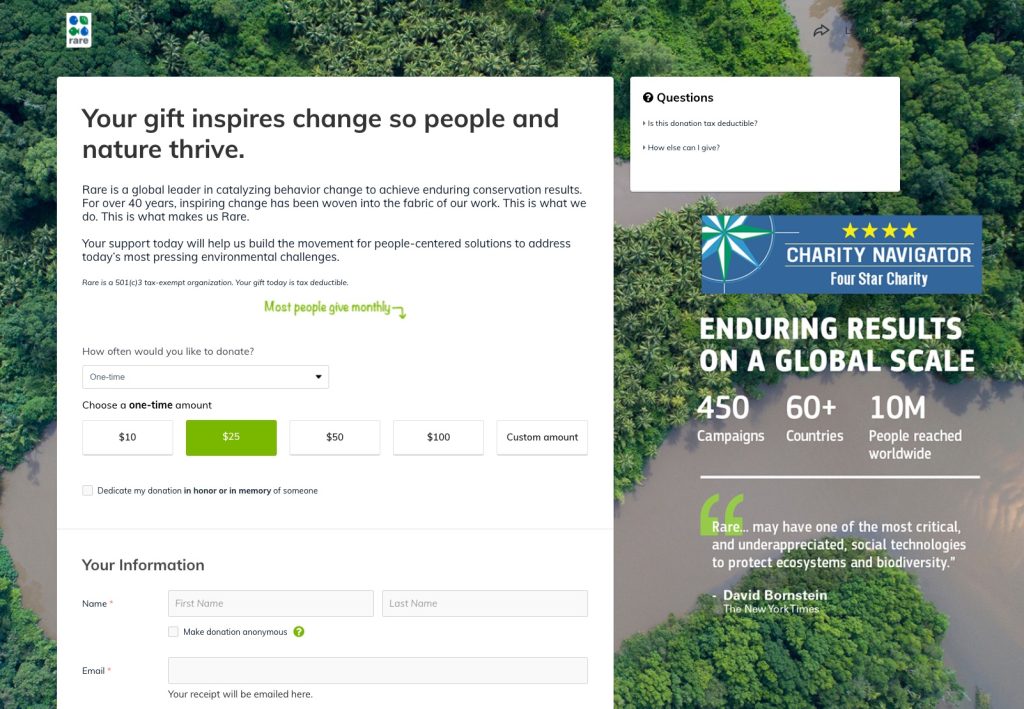
Not only is this page branded, but it also works well for a number of other reasons:
- It’s hosted on their main website (not another domain like givingapp.com/rare).
- It’s written with high-impact, donor-centric copy.
- It’s designed to build trust through endorsements, statistics, and testimonials.
- It offers multiple donation amounts that are reasonable.
- It offers single-time and recurring donation options.
- It goes preemptively answers user questions with FAQs at the top.
Key Benefit #5: Saves You Time and Money
Another very practical benefit of a strong nonprofit brand is organizational efficiency. Again, this is true for both small scrappy nonprofits as well as massive international organizations.
How, you might ask?
Well, by having a written brand guide—encompassing everything from your mission and audience personas to your messaging, logo, and visual design elements—you have a ready-made “messaging packet” for anyone who works with your organization.
You can refer to this packet while doing any kind of nonprofit marketing or communications:
- Training new hires or volunteers
- Contracting out your copywriting or design work
- Setting and assessing quarterly goals
- Writing and designing your annual impact report
- Writing grant applications
- Creating social posts for Facebook, Twitter, Instagram, or LinkedIn
- Prepping for press events
To borrow a concept coined by Don Norman (the pioneer of user experience design), a written brand strategy will help keep information “in the world” rather than “in the head.” The more you can externalize information including your brand, the easier it becomes to use it—and the more cost-effective.
Think of how much time and energy you could save if…
- Your freelance designers already had your brand info before creating an infographic or other nonprofit marketing piece.
- You didn’t have to think about what color or font to use when creating a new page for your nonprofit website.
- You didn’t have to spend hours brainstorming something, anything to post on social media to meet your quarterly engagement KPI.
- You didn’t have to send hundreds of edit requests to your volunteer copywriter because the writing was good…but the tone just wasn’t quite right.
Over months and years, this can translate into dozens or even hundreds of hours saved, simply by cataloguing your nonprofit’s already-existing brand.
To see an example of a great brand guide in action, check out this nonprofit brand guide from Soles4Souls, covering everything from colors to font to values.
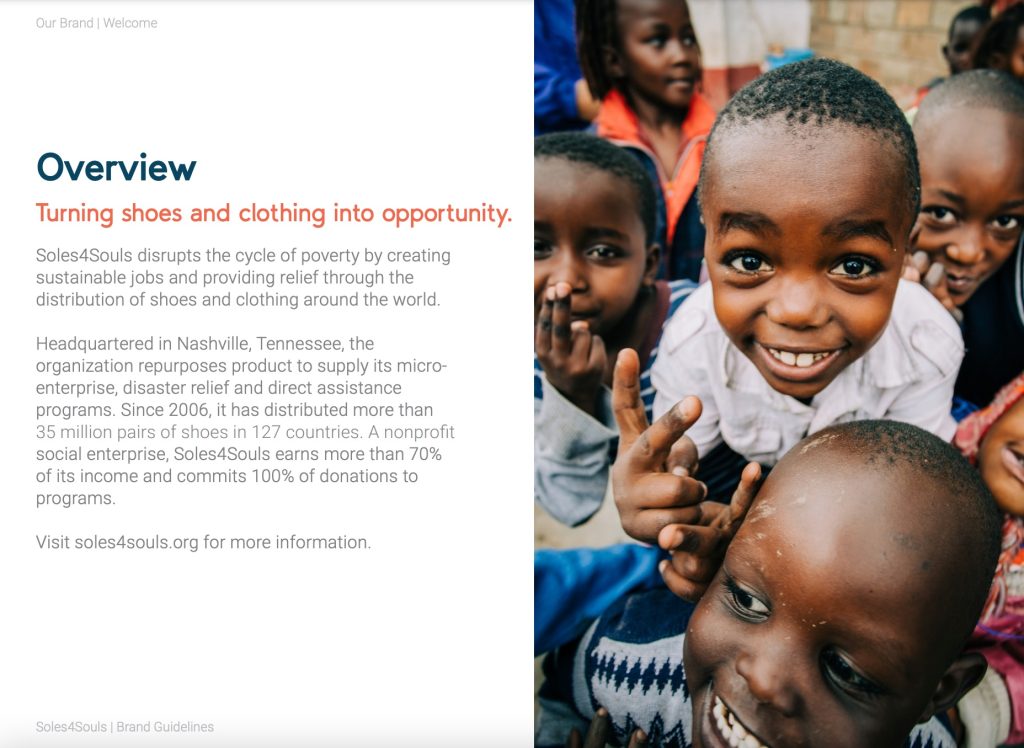
Key Benefit #6: Creates Brand Ambassadors
“A brand is no longer what we tell the consumer it is—it is what consumers tell each other it is.” – Scott Cook, co-founder of Intuit
This quote perfectly captures the last benefit of strong nonprofit branding.
It not only gives people something to talk about; it gives them the tools they need to spread your mission on your behalf.
With a clear and well-designed brand, you’re giving your community the opportunity to become natural and enthusiastic ambassadors for you. They can take your messaging, your logo, your color palette, and—most importantly—your mission and share it with their networks online and off. This is the best form of nonprofit marketing because it’s authentic and natural.
Think about the ubiquity of NPR tote bags among a certain demographic or the equality stickers from the Human Rights campaign.
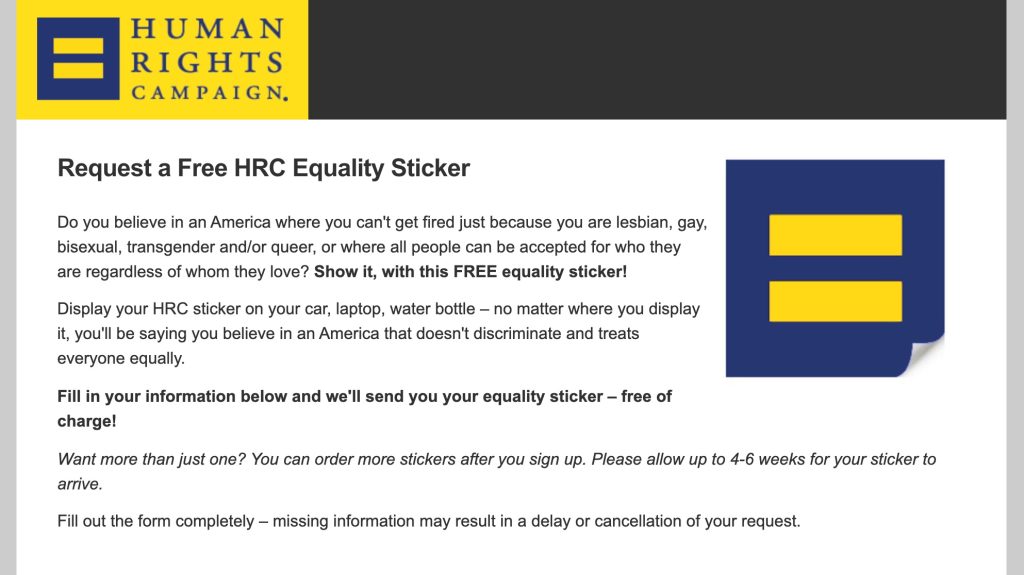
Whether your nonprofit has an e-commerce element or you use freebies like stickers, a strong brand is the foundation for turning a passive audience into an active community.
You can move away from the model of “we the organization do” to something more democratic, like “we—all of us, together—do.” By giving your most loyal fans a clearly packaged brand, you’re providing everything they need to take your brand and run with it.
And the further they run, the more your impact spreads!
Why I’m a Brand Skeptic No More
With all of these awesome benefits in mind, I hope you’ll remember one important thing.
Your nonprofit branding is NOT just the visual expression like colors, font, and logo.
Your brand is your vision, your values, your personality, and your story. It’s how you want people to remember you (and what you do to be memorable!). It’s how you subtly, repeatedly, and consistently answer the question, “Why us?”
Oh, and one more thing before I go. I have a little confession to make: I used to be a brand skeptic. I was once firmly in the camp that equated a good brand with monetary gain or a frivolous waste of resources—something that a “responsible steward” wouldn’t waste too much time or effort on.
But boy was I wrong!
The more we’ve worked with impact organizations and the more time we’ve spent in digital marketing and nonprofit website strategy, the more we’ve seen exactly how much a clearly articulated, thoughtfully expressed brand matters—especially for impact organizations.
A strong brand multiplies your impact, frees up critical resources to do more of the good work you’re already doing, and ensures that your nonprofit has an identity that lasts beyond any single project or grant. From your website to email newsletters to print marketing, communicating your mission through brand is what empowers others to join you.
For more tips, check out our post on what goes into a great nonprofit brand.
If you want some insight on nonprofit branding that goes deeper than this post, we’d love to have a free strategy call with you.